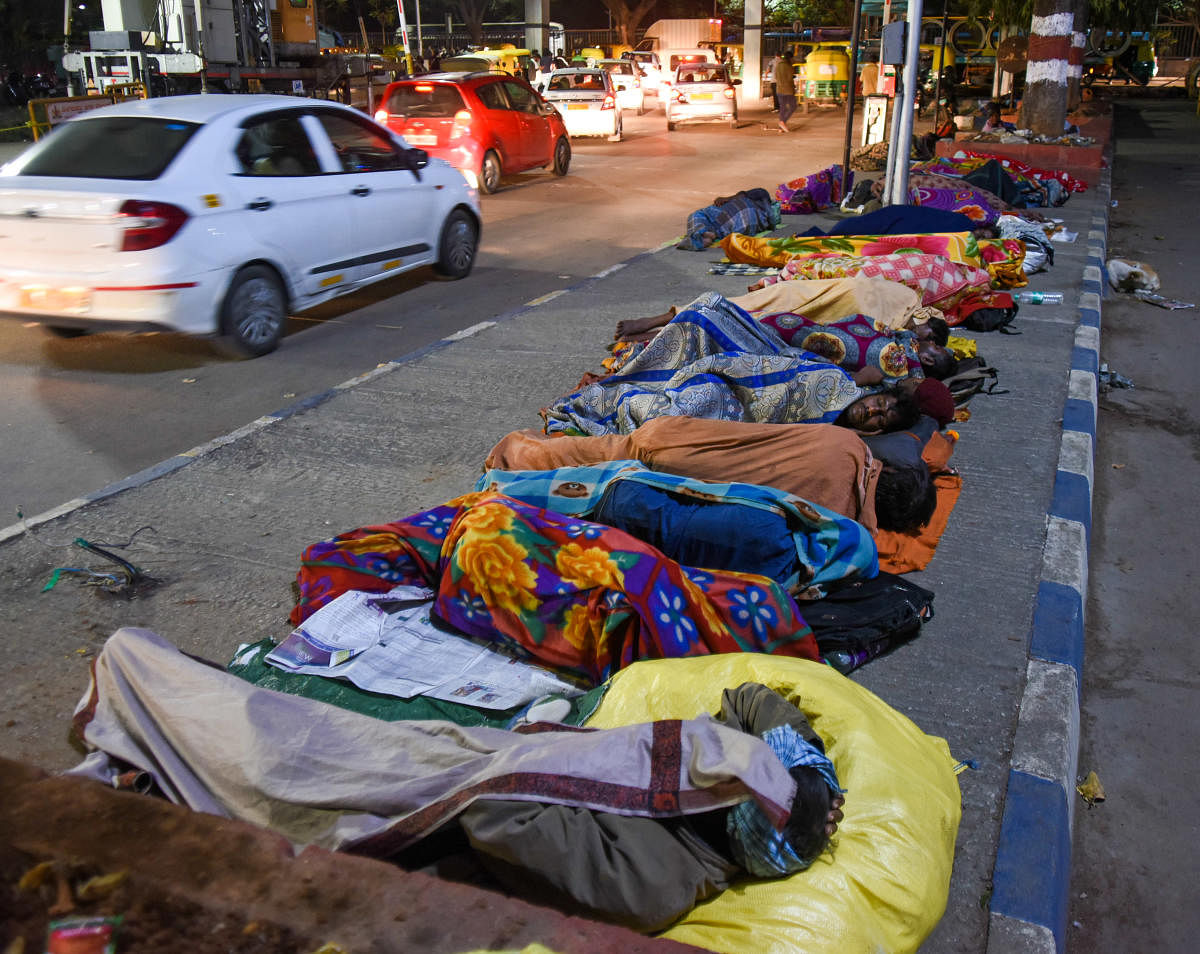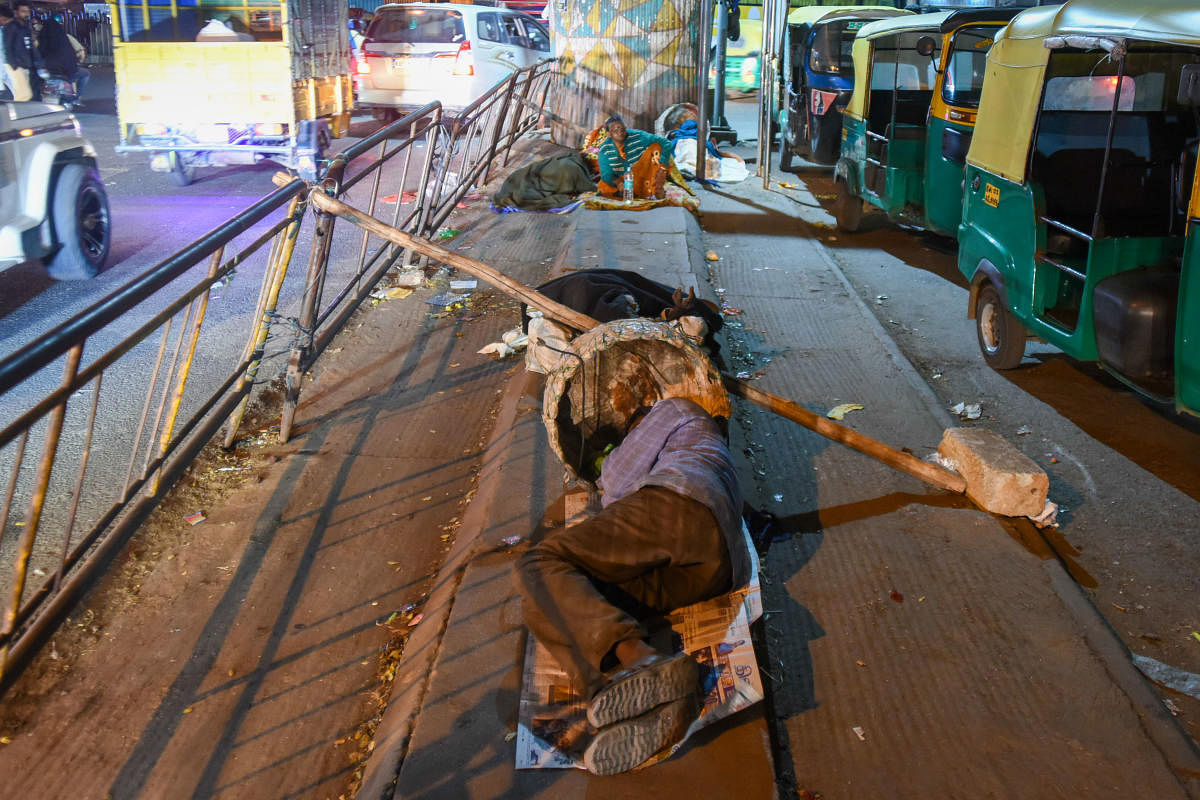

Piles of gunny bags lay here and there under the BGS flyover near KR Market. One of them moved to reveal the head and arms of a living human being. Across the road on the pavement, a man tried to cover himself with cardboard sheets, under the starlit sky. Many had already settled inside gunny bags, with no protection from cold and mosquitoes.
A recce by DH journalists near Kalasipalya, K R Market, K S R Railway station and nearby areas revealed hundreds of people sleeping on the streets. Many slept on pavements, while some were on pushcarts. Some had blankets, and many had nothing.
Outside the K S R Railway station, many ragpickers slept on footpaths, making pillows out of their plastic collection. In the morning they would sell it and make money, and collect more plastic from the station.
Cleanliness is a big issue for the homeless, as there are no public bathing facilities, other than some Sulabh Shouchalayas. They are refused jobs because they are not clean enough.
One bath and a set of clean used clothes cost anywhere between Rs 150-200. Some NGOs provide bathing coupons to people on the streets, who can use them to take bath in private bathing facilities, called hammams.
“Just helping them with bath and clean clothes can make a lot of difference in their lives,” says the volunteer, citing examples of people who got employed just by being clean.
Concentrated in transit hubs
Most of the homeless are found in the transit hubs and markets of the city, such as Majestic, K R Market area and Yashwanthpur, essentially in East, West and South zones, says Ram Sampath, co-ordinator of Impact India Consortium.
In March 2010, a rapid survey of urban homeless in Bengaluru city carried out by a consortium of NGOs found that there were at least 17,141 homeless people in BBMP limits. Another survey conducted in 2019 before Covid identified 5,109 homeless people. During Covid, homelessness peaked, but there is no data related to this.
As per a Supreme Court order issued in January 2010, all cities covered under JNNURM having above 5 lakh population must have one homeless shelter with a capacity of 100 persons for every one lakh population, operational round the clock throughout the year.
There should be 84 shelters within BBMP limits according to this. There were only six functional night shelters in January 2018. After being rapped by the High Court in July 2021 on meeting the night shelter target, the BBMP scrambled and could make 26 of them operational by January 2022.
Today there are 48 operational night shelters in Bengaluru, that can accommodate 1477 homeless people. August 2022 was the deadline to make overall 63 shelters functional, but the work has been slow.
Problem of exclusion
The upper hallways of markets empty after the daily business turn resting spots for headloaders and daily labourers working in the market. The people DH spoke to were comfortable with this and did not want to move into night shelters.
However, this is not always the case. Volunteers working with the homeless say that many of them suffer from psychiatric or psychological problems, which is why they become homeless, being rejected by their own. In such cases, it becomes difficult to integrate them into regular night shelters.
Addictions are common among the homeless. “Alcoholism is a common issue. But if you think from their perspective, they need to drink in order to get a good night’s sleep on the pavements, open to abuse and weather extremes,” says another volunteer who works with the homeless.
Those with addictions are not taken into night shelters. The volunteer explains: “Night shelters have strict rules and don’t want to take in alcoholics or addicts, disabled and people with physical and mental health issues. There are no direct de-addiction programmes attached to shelter homes in reality.”
Even among women, the condition is that they should be able-bodied and working. Thus, though nobody admits it, many vulnerable people are left on the streets, without food, medicine, treatment and help.
Need for special arrangements
Sampath says that the people still on the streets are picking rags or begging, and the already existing crowd in the shelters may not like to mingle with them, therefore most shelters have a problem admitting them. “Special arrangements must be made for these people,” he says.
When this was brought to the notice of V Ram Prasath Manohar, Special Commissioner in charge of social welfare, he said that arrangements will be made for these people in future.
When asked why there are still homeless people on roads sleeping everywhere, Manohar said: “This is a perennial issue. BBMP has enough night shelters. But when our people go and request them, they are not willing to come into shelters. They say they are comfortable with the current arrangement. Beyond a point, we can’t force a person.” He promised affirmative action to include more people on the streets in night shelters.
Though the BBMP says there are awareness programmes about the shelters, they are not visible enough. With various stigmas plaguing the system and practical solutions absent, many vulnerable people continue to sleep on the streets of Bengaluru.